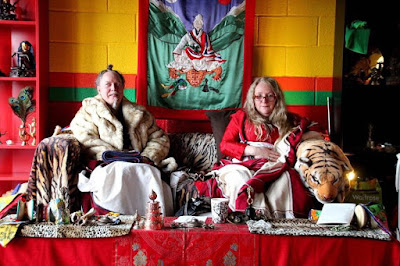 |
| Naljorpa Ja'gyür & Ngakma Métsal |
The three-day series of talks and presentations will address Vajrayāna’s dialogue with 21st century medicine and science as well as its current and historical interface with the visual and performing arts. Presentations will emphasize Vajrayāna’s long history of creative adaptation within wider processes of continuity and change and the current globalization of Himalayan Buddhist culture. The conference will specifically address the role of body-mind yogic practices within Vajrayāna Buddhism and their applicability within an increasingly transcultural and technologically driven world.
Ngakma Mé-tsal and Naljorpa Ja’gyür will give a talk entitled 'When a Return to Tradition appears as Innovation: Essential Insights into the Origins of Vajrayāna Buddhism'.
The conference promises to be a fascinating opportunity to meet with fellow Vajrayana practitioners, to present the teachings of the Aro gTér Lineage and our plans for Drala Jong.
When a Return to Tradition Appears as Innovation: Essential Insights into the Origins of Vajrayāna Buddhism
Ngakma Mé-tsal Wangmo & Naljorpa Ja’gyür Dorje
Vajrayāna as it was first transmitted in India and Tibet bears little resemblance to the institutionalized forms current in the contemporary world. As a result, the very essence of Vajrayāna thought and practice has often been obscured by secondary cultural and political developments.
This presentation will illuminate the original ethos and practice of Vajrayāna, prior to its later culturally determined modifications. Central to this is the advanced psychology expressed in the lives and teachings of the tantric mahāsiddhas and their relevance to Buddhist practice in everyday life.
This presentation will thus explore several interconnected subjects that reveal the deep relevance of the original Vajrayāna teachings in the world today.
These subjects are as follows:
- The 84 Mahāsiddhas as visualization and mantra practices, from the revealed treasures (gTérma) of Jomo Pema ’ö-Zér, which, along with their associated hagiographies, elucidate the principles and functions of individual life in the process of liberation.;
- The history of the gos dKar lCang lo’i sDe (ngakpa sangha), as distinct from the more widely known tradition of Tibetan Buddhist monasticism;
- The mKha’ ’gro dPa bo nyi zLa me long rGyud, essential teachings on vajra love as an approach to the non-dual state of liberated awareness;
- Insights into Aro gTér sKu-mNyé: the 111 Dzogchen long-dé cycle of psycho-physical practices for realizing non-duality, exercises which employ the body as the portal of discovery;
- Essential Vajrayāna psychology as applicable in the contemporary world, where every state of mind, however distressing, is linked dynamically to an aspect of the intrinsic freedom of the non-dual play of the elements.
Mé-tsal Wangmo and Ja’gyür Dorje are a teaching couple within the Aro gTér lineage of Tibetan Buddhism. They have been ordained as go kar chang lo practitioners and students of Ngak’chang Rinpoche and Khandro Déchen, the lineage holders of the Aro gTér since the 1990s. They combine careers in IT project management, education and Chinese medicine with family life and practicing and teaching Vajrayāna. As well as teaching publicly, they have personal students in Britain, mainland Europe, and South America.
About the Conference
Further information about the conference is available from the website of The Centre for Bhutan Studies and GNH Research, and also on Facebook
The Drala Jong project seeks to create a home for the Aro gTér Lineage. Please see the Appeal page for more information about the Drala Jong project and how to help.
If you would like to make a single or regular donation, please click the button below.










